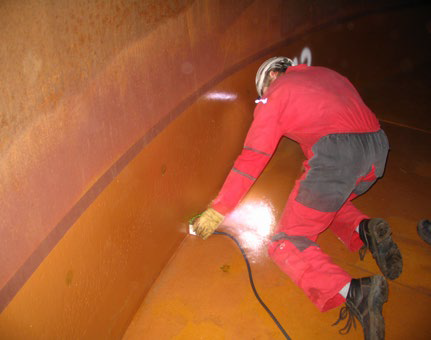A Thorough Introduction of Storage Tank Welding Assessment Criteria and Methodologies for Improved Weld Quality and Performance
The value of welding examination requirements in the production of tanks can not be overemphasized, as they function as the foundation for ensuring weld stability and operational dependability. Numerous examination methods, including aesthetic assessments and advanced non-destructive testing techniques, are vital in recognizing prospective problems that might jeopardize efficiency. Adhering to regulatory criteria not only boosts weld top quality however also alleviates the danger of pricey failures. As we check out the nuances of these methodologies, it becomes necessary to think about exactly how a systematic approach can change present practices and result in significant improvements in results.
Relevance of Welding Inspection Requirements

Welding assessment requirements encompass a series of criteria, consisting of material specs, welding treatments, and certifications of employees entailed in the welding process. By imposing these standards, organizations can systematically determine and correct prospective flaws, therefore lowering the chance of pricey repairs or devastating failures. Strenuous evaluation techniques promote a culture of responsibility and precision, urging welders to keep high levels of workmanship.

Typical Welding Inspection Methods


Ultrasonic Checking (UT) is one more prevalent strategy, making use of high-frequency acoustic waves to find inner problems that might not be noticeable on the surface. This approach is especially effective for determining voids or additions within the weld metal. Magnetic Bit Evaluating (MT) is likewise widely made use of, particularly for ferromagnetic products, as it discloses surface and near-surface issues through the application of electromagnetic fields and ferrous particles.
In Addition, Fluid Penetrant Testing (PT) discovers surface-breaking defects by using a penetrant to the weld and after that utilizing a programmer to extract the penetrant. Each of these strategies adds to a detailed assessment approach, ensuring that welds meet the stringent top quality standards needed in storage tank building.
Regulatory Specifications and Compliance
Regulatory criteria and compliance are vital components in ensuring the safety and dependability of bonded frameworks in storage tank building - Tank Welding Inspection. These standards serve to establish minimum requirements for material residential or commercial properties, welding procedures, and evaluation methods, thus reducing the danger of structural failures and improving overall efficiency
Secret companies, such as the American Culture of Mechanical Designers (ASME) and the American Welding Society (AWS), give guidelines that are widely taken on in the sector. Conformity with these requirements not only guarantees adherence to finest techniques however likewise fulfills legal and legal obligations, guarding the rate of interests of stakeholders.
Regulatory bodies frequently mandate adherence to specific codes, such as ASME Code Section IX for welding certifications and API 650 for welded storage tanks. These codes lay out demands for welding techniques, credentials of employees, and screening methods to verify weld honesty.
Routine audits and assessments are crucial to keeping conformity, as they help recognize discrepancies from developed criteria. Non-compliance can lead to considerable fines, project delays, and security dangers. Hence, a robust understanding of regulatory standards and a dedication to compliance are extremely important in attaining top quality and long lasting bonded tank structures.
Non-Destructive Testing Methods
How can the stability of welded frameworks be ensured without triggering damage? Non-destructive screening (NDT) techniques provide a robust remedy, allowing examiners to examine weld high quality without jeopardizing the product - Tank Welding Inspection. Amongst the most common NDT strategies are ultrasonic testing (UT), radiographic testing (RT), magnetic bit testing (MT), and color penetrant testing (PT)
Radiographic screening entails passing X-rays or gamma rays with the weld, creating pictures that expose architectural defects such as cracks or spaces. This method is important for examining the honesty of complicated welds.
Magnetic bit screening is fit for ferromagnetic materials, where magnetic fields expose surface area and near-surface stoppages. Dye penetrant screening makes use of a fluid color to highlight surface-breaking defects, making it an efficient method for non-porous products.
Each of these NDT methods has distinctive advantages, permitting detailed analyses customized to specific materials and welding processes. By implementing these methods, sectors can make sure the dependability and safety of bonded frameworks, ultimately enhancing overall efficiency.
Enhancing Weld Quality With Inspection
Reliable assessment plays a vital duty in enhancing weld high quality, acting as a vital checkpoint in the manufacture procedure. By identifying possible flaws early, inspections minimize the threat of compromised structural honesty and make sure conformity with market requirements. Employing a combination of aesthetic evaluations, non-destructive testing (NDT) techniques, and mechanical assessments, assessors can detect problems such as porosity, fractures, and insufficient combination.
Implementing a durable assessment protocol not only enhances the general high quality of welds but additionally fosters a society my sources of liability amongst welders and makers. Regular training and accreditation of inspection personnel guarantee that they are furnished with the needed skills to identify and attend to possible problems successfully. This positive approach decreases rework and connected expenses, find out this here eventually adding to predict effectiveness.
Furthermore, comprehensive documents of examination searchings for supplies beneficial understandings right into recurring issues, assisting in continual enhancement in welding methods. By leveraging sophisticated modern technologies, such as automated ultrasonic testing or digital radiography, weld top quality can be boosted via a lot more precise examinations. In conclusion, a strenuous examination procedure is essential in attaining premium welds, making sure safety, reliability, and longevity in tank construction.
Final Thought
In conclusion, the execution of strenuous tank welding examination criteria and techniques is crucial for making sure weld integrity and efficiency. By using a combination of visual inspections, non-destructive screening approaches, and adherence YOURURL.com to governing requirements, organizations can successfully identify and minimize prospective flaws.